 Day 3 of this years SESI conference has come and gone, and I’m sorry it’s over. I’ve learned several interesting new things, none of which, unfortunately, I’m free to publish. But news on these items should be coming out soon, hopefully on this blog. Sorry for the tease, but there are some good and interesting things in the works.
Day 3 of this years SESI conference has come and gone, and I’m sorry it’s over. I’ve learned several interesting new things, none of which, unfortunately, I’m free to publish. But news on these items should be coming out soon, hopefully on this blog. Sorry for the tease, but there are some good and interesting things in the works.
 Several Space-Elevator themed presentations were given today. Tom Nugent of LiftPort started it off with a talk on the “Rationale behind LiftPort’s Beta Roadmap.” Tom gave a persuasive case of why this was important to do; that it was important to try and get a “real” date out there and to show the justification behind it. One can argue with the details all they want (in fact this is encouraged), but the roadmap (Project Plan, if you will) is a necessary step.
Several Space-Elevator themed presentations were given today. Tom Nugent of LiftPort started it off with a talk on the “Rationale behind LiftPort’s Beta Roadmap.” Tom gave a persuasive case of why this was important to do; that it was important to try and get a “real” date out there and to show the justification behind it. One can argue with the details all they want (in fact this is encouraged), but the roadmap (Project Plan, if you will) is a necessary step.
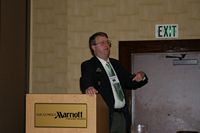 Bryan Laubscher, of Black Line Ascension (and other things too, I think – I’ll have to check) then gave a talk on “Space Elevator and Rocket Cost Comparison.” Bryan ran through the numbers on the best efficiency that can be expected from chemical rockets and showed why the Space Elevator was just a better way to get things out of our gravity well.
Bryan Laubscher, of Black Line Ascension (and other things too, I think – I’ll have to check) then gave a talk on “Space Elevator and Rocket Cost Comparison.” Bryan ran through the numbers on the best efficiency that can be expected from chemical rockets and showed why the Space Elevator was just a better way to get things out of our gravity well.
After a break, Bryan then gave a talk on “The Space Elevator and Planetary Defense”. Bryan talked about the very real threat that comets and asteroids present to our planet and the role that the Space Elevator can play in mitigating this threat.
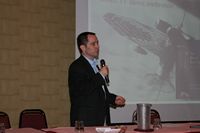 Brad Edwards then gave a presentation on a new organization, the “European Spaceward Association”. This organization is so new, they don’t even have a website up. (Correction – yes they do. As noted in a comment, their new site is at www.eurospaceward.org) They’ve been organized to help foster interest in Europe towards developing a Space Elevator. My readers may recall an article I posted a few weeks ago on the German Space Elevator games, scheduled for next year. One of European Spaceward Association’s activities is going to be working with the Germans on organizing these games. I think I have a very good reason to visit Germany next year !
Brad Edwards then gave a presentation on a new organization, the “European Spaceward Association”. This organization is so new, they don’t even have a website up. (Correction – yes they do. As noted in a comment, their new site is at www.eurospaceward.org) They’ve been organized to help foster interest in Europe towards developing a Space Elevator. My readers may recall an article I posted a few weeks ago on the German Space Elevator games, scheduled for next year. One of European Spaceward Association’s activities is going to be working with the Germans on organizing these games. I think I have a very good reason to visit Germany next year !
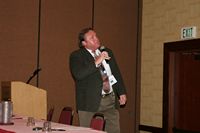 A talk was then given on “Some Aspects of Space Elevator Ribbon Elastic Stress and Length Reduction.” Unfortunately the authors, Armenian by nationality, were unable to attend (visa problems, perhaps). so one of the other attendees, Paul Edelman, had to fill in. He did a noble job on a very difficult assignment.
A talk was then given on “Some Aspects of Space Elevator Ribbon Elastic Stress and Length Reduction.” Unfortunately the authors, Armenian by nationality, were unable to attend (visa problems, perhaps). so one of the other attendees, Paul Edelman, had to fill in. He did a noble job on a very difficult assignment.
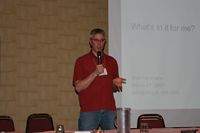 The next talk was on “The Space Elevator: What’s in it for me” and was presnted by Brad Neumann. Brad’s talk was really interesting and, IMHO, very timely. Brad told us that if we wanted to get people excited about building a Space Elevator, we had to demonstrate the urgency ourselves and to engage other people in this by asking them what benefit THEY think they could get out of it and then LISTENING to the answers.
The next talk was on “The Space Elevator: What’s in it for me” and was presnted by Brad Neumann. Brad’s talk was really interesting and, IMHO, very timely. Brad told us that if we wanted to get people excited about building a Space Elevator, we had to demonstrate the urgency ourselves and to engage other people in this by asking them what benefit THEY think they could get out of it and then LISTENING to the answers.
Next up was Tom Nugent, combining his presentation of the “Space Elevator Questions Database” and Michael Laine’s presentation of the “Four Pillars of Infrastructure Development to the Space Elevator” into one extended talk (Michael was unable to attend the conference – the rumor is that he fell down the stairs and injured himself – Tom denies any involvement in this 🙂 ) Tom talked about what the Questions database is and why it could be an important resource if properly used. He then discussed the “Four Pillars” necessary to get something like the Space Elevator (or any large infrastructure project) built; Technology, Finance & Business, Legal and Social/Political support. Without all these players on board, LiftPort contends that the Space Elevator won’t happen. It’s a good argument.
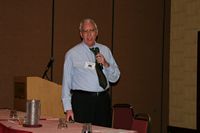 Fred Cowan of Raytheon then gave a presentation on “A Different Space Elevator Approach”, a most informative and stimulating presentation.
Fred Cowan of Raytheon then gave a presentation on “A Different Space Elevator Approach”, a most informative and stimulating presentation.
Finally, Bryan Laubscher wound up the day’s presentations with “The Space Elevator and its Role in Mitigating Threats to Earth.” Bryan talked about some really far out possible threats to earth (black holes, Novas, neutron stars, etc.). He contends that, once we have put into place adequate defenses to guard the earth against the more imminent threats of comets and asteroids, we should then use the Space Elevator’s capabilities to begin to think about how we deal with these longer-term issues.
A full day and a truly enjoyable one. If you believe in the concept of a Space Elevator, like I do, the stuff presented today was truly “red meat”. Tomorrow’s presentations promise to be just as stimulating.
More tomorrow – but probably very late as I’ll be traveling back home after the conference.
As always, click on the thumbnails for a larger version.

Dear Ted
Thanks a lot for your interesting blog coverage of the SE presentations at Spaceex in Albuquerque! Just to add: EuroSpaceward’s website http://www.eurospaceward.org is under construction at http://eurospaceward.org/index.php. Have a look there and find out that we plan to position the association on the environmental & quality & safety “musts” for planet Earth (and all of us thereon) of colonizing space in a sustainable way by space elevator as well as by other means.
Best regards
Markus Klettner
SDG
EuroSpaceward A.s.b.l.
16, rue Michel Rodange
L-8085 Luxembourg
NIce job. Are they going to publish the presentation papers?
Pingback: Not In Kansas Anymore » Not Enough Goofiness in Albuquerque
Markus, I’ve updated the blog posting with your web site.
Brian, yes they are. They published the proceedings of the last conference in book form and plan on doing so again this year. I’m not sure when they’ll come out, but I’ll blog about it when it happens.
Thanks for the round up at the conference!
Sad to see that Michael Laine and others couldn’t make it, but it must have been great to meet some of the pioneers in the field.
I listened to some of the audio and read some of the presentations on liftport (from Tom), and it seems to me that humans may not be going on an SE anytime soon (2040 is my best guess).
Unless Brad Edwards has a magic trick in his pocket (or you have not revealed key info) then I may have to seriously consider saving up for a rocket ride via Virgin Galactic.
A book form? I was hoping for something to link to that many many people could actually see.
You know – so people who are not invested in the idea can find out about it. If you’re not there intellectually or emotionally having to pony up for an actual book is too high a barrier.
Brian, I’m just guessing it’s a book form as this is what they did last time. I don’t really know for sure.
And Darnell, you might be right. But Brad didn’t appear to be too worried, so I’m not yet either…